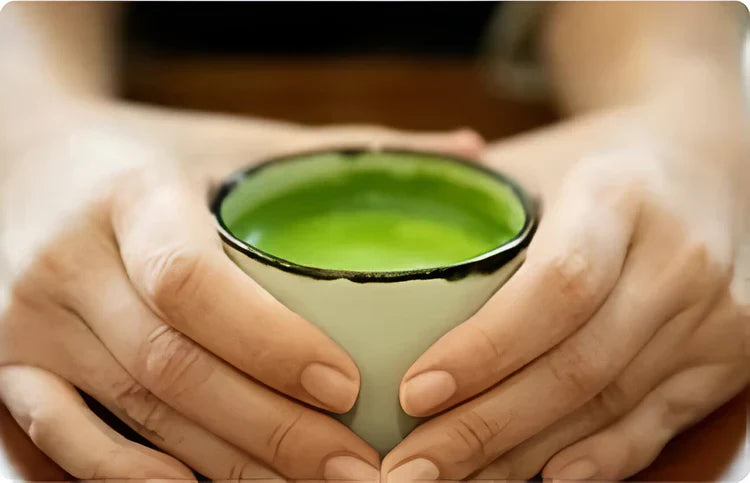
The Legend of Tea
Share
Journey Through Time with DōMatcha
At DōMatcha®, we’re passionate about tea and its rich history, steeped in culture and legend.

Many tales explain why tea became a cherished beverage. One story revolves around Wan Tu, a Chinese emperor exiled to the region of Yunnan in 2737 BC [1] due to his harsh rule. While resting under a large bush, he noticed the leaves and placed them in hot water. He took a sip and felt a surge of energy and excitement. [2] Others believe he accidently ingested the water with tea leaves. [1]
Another story, involves Shennong (神農), variously translated as "Divine Farmer"[3] born Jiang Shinian (姜石年).
He was a mythological Chinese ruler known as the first Yan Emperor who has become a deity in Chinese and Vietnamese folk religion. Shennong is credited with identifying hundreds of medical (and poisonous) herbs by personally testing their properties, which was crucial to the development of traditional Chinese medicine.
Legend holds that Shennong discovered tea, which he found it to be acting as an antidote against the poisonous effects of some seventy herbs he tested on his body. Shennong first tasted it, traditionally in ca. 2437 BC, from tea leaves on burning tea twigs, after they were carried up from the fire by the hot air, landing in his cauldron of boiling water. [5]
According to some versions of the myths about Shennong, he eventually died because of his research into the properties of plants by experimenting upon his own body, after, in one of his tests, he ate the yellow flower of a weed that caused his intestines to rupture before he had time to swallow his antidotal tea. [6]
Shennong is venerated as the Father of Chinese medicine. He is also believed to have introduced the technique of acupuncture. [6]

Tea's journey spread to Japan, when tea seeds were first brought to Japan in the early 9th century by the Buddhist monks Saicho and Kūkai. During the Heian period (794–1185), The Zen Buddhist priest Eisai (1141–1215), founder of the Rinzai school of Buddhism, brought tea seeds from China to plant in various places in Japan. Eisai advocated that all people, not just Buddhist monks and the elite, drink tea for its health benefits.[7]
In 1211, at the age of 71, he penned "Kissa Yōjōki (喫茶養生記 Book of Tea, lit. Record [of] Drinking Tea [for] Nourishing Life,” [7] where he expressed his belief in tea's holistic benefits for both body and mind and describes how drinking green tea may affect five vital organs, the shapes of tea plants, flowers and leaves, and how to grow and process tea leaves.

The oldest tea-producing region in Japan is Uji, located near the former capital of Kyoto.[7] It is thought that seeds sent by Eisai were planted in Uji, becoming the basis of the tea industry there.[7] Today, Japan's most expensive premium teas are still grown in Uji.[7]
DōMatcha® Japanese stone-ground green tea is directly from Kagoshima and Uji, Kyoto. DōMatcha® ‘s supplier is based in Uji, Kyoto and has been in the tea business for 300 years and is partnered with the famous 16th-generation Japanese tea master Kazunori Handa-san, whose family’s knowledge and expertise have been handed down generation after generation for over 400 years.
With over 3,000 years of history, tea has been the subject of extensive scientific research, uncovering the unique components that contribute to its delightful taste, colour, aroma, and remarkable health benefits according to ancient emperors, priests and monks.
Want to experience the closest thing to authentic matcha tea today?

Imperial Ceremonial Matcha
Experience the unique taste of our hand-picked ceremonial grade matcha, perfect for Koicha (thick matcha) used in traditional Tea Ceremonies.
Sourced from Uji, Kyoto, this superior matcha boasts a smoother, rounder palate and high L-theanine content, enhancing both flavor and calmness.
Exclusively blended by a 16th-generation tea master, this limited edition matcha is ideal for enjoying as a traditional whisked beverage.
[1] https://www.hackberrytea.com/blogs/tea-education/green-tea-101-history-processing-and-health-benefits
[2] Scientic Evidence for the Health Benefits of Green Tea, Japan Tea Central Public Interst Incorporated Association
[3] Ivanhoe, Philip J.; Van Norden, Bryan W. (2005). Readings in Classical Chinese Philosophy (2nd ed.). Indianapolis: Hackett Publishing Company. p. 381
[4] Khan N, Mukhtar H (2013). "Tea and health: studies in humans". Current Pharmaceutical Design (Literature Review). 19 (34): 6141–7
[5] Jane Reynolds; Phil Gates; Gaden Robinson (1994). 365 Days of Nature and Discovery. New York: Harry N. Adams. p. 44.
[6] https://en.wikipedia.org/wiki/Shennong
[7] https://en.wikipedia.org/wiki/Green_tea